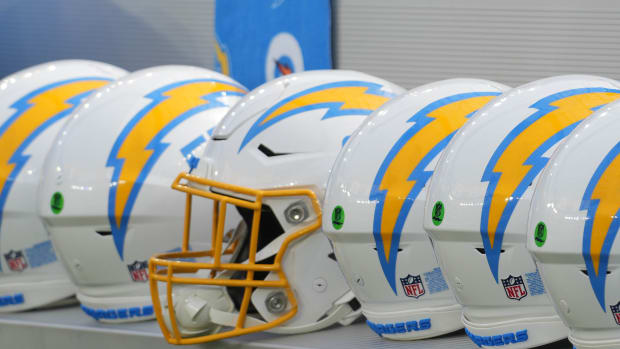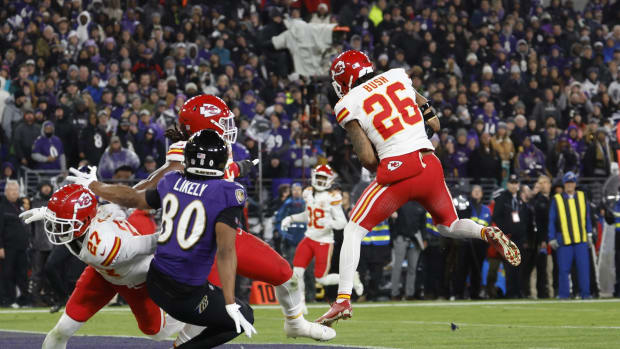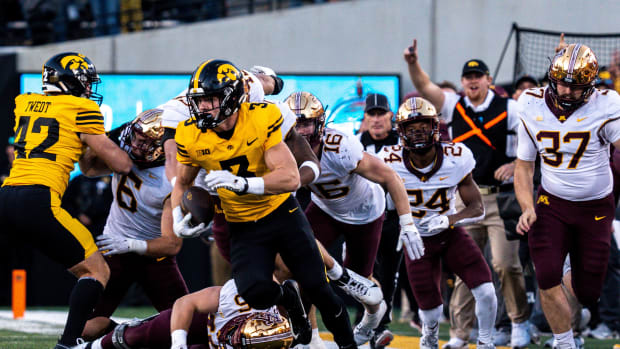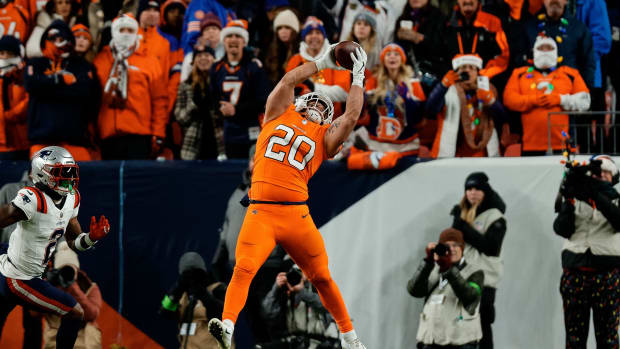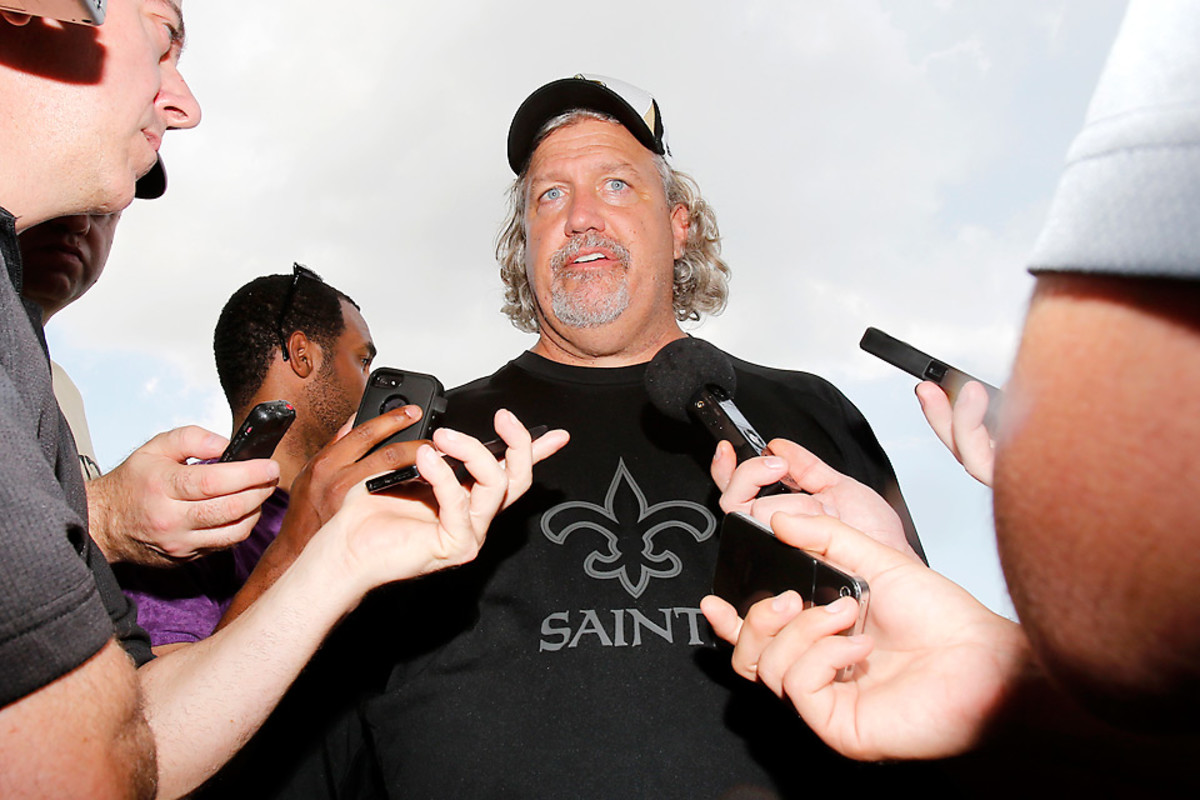
Saints Preview: Just a Little Bit of 'D' Will Do
They’ve served their Bountygate sentences, and now the Saints can go back to being contenders again ... right? General manager Mickey Loomis returned from his suspension in Week 10 last season. Assistant head coach Joe Vitt was back in Week 8, and the players’ appeals were upheld by nonpartisan judge Paul Tagliabue in December. The franchise’s final penance was paid this past April when it forfeited its second-round draft pick.
That was three months after Sean Payton’s reinstatement. Having the eighth-year head coach back is a huge plus, but it’s unlikely that Payton’s mere presence will fix the issues that made the Saints a 7-9 team last season. His primary focus is the offense—which, despite some occasional choppiness, was its usual productive self. Even during an 0-4 start, New Orleans averaged 27.5 points and 401.5 yards per game. For the season, the Saints ranked third in scoring (28.8 points per game) and second in yardage (410.8 per game).
Those numbers were basically identical to what the Saints put up from 2009-11. But it wasn’t enough to compensate for a defense that allowed an all-time worst 440 yards per game. Big plays were always there for the taking; the Saints allowed a league-high 36 gains of 30-plus yards, and they surrendered two of the three 90-yard plays in the NFL last season.
No coach could have succeeded with New Orleans’ defense, particularly after it was ravaged by injuries at cornerback. Still, record-setting futility demands a fall guy. Defensive coordinator Steve Spagnuolo was an obvious candidate after Payton and Loomis decided to install a new 3-4 scheme in 2013.
To direct the 3-4, the Saints hired Rob Ryan as defensive coordinator—he’s now held the job with four teams in 10 years. The garrulous Ryan is saddled with a lot of the same players Spagnuolo had. They are learning an intricate system that has them operating from a totally unfamiliar alignment. It will be next to impossible for Ryan to turn things around right away. But the good news is he doesn’t have to take this defense to the top, he just has to take it back to the middle. The other side of the ball can handle the heavy lifting.
OFFENSE
Before they out-execute opponents, the Saints out-scheme them. Though offensive coordinator Pete Carmichael Jr. has called a lot of New Orleans’ plays over the past two seasons, Payton will continue working closely with Drew Brees on the weekly game plans. Having a quarterback who goes through his progressions with the rapid exactness of an automated program gives the trendsetting offensive architect endless possibilities.
Though the Saints are known for using an expansive array of weapons—by season’s end they generally have six or seven players with 500-plus yards from scrimmage—most of the mismatches they create center around three players: tight end Jimmy Graham, wide receiver Marques Colston and running back Darren Sproles.
Graham, an insanely athletic 6-7, 260-pounder, can easily beat any linebacker and most safeties from his standard tight end spot, and especially out of the slot or an outside receiver alignment. Normally, defenses would put a cornerback on him, but New Orleans’ commitment to a power run game discourages that. Colston gives the passing game its steadiness. He doesn’t have enough speed or initial quickness to consistently get open by himself on the outside, but when aligned inside off the line, he’s one of the toughest covers in the league. Save for an injury-marred 2008 campaign, the former seventh-round pick has had at least 70 catches, 1,000 yards and seven touchdowns every season. (But never more than 1,202 yards or 11 touchdowns; the man’s consistency is matched only by that of the earth’s rotation.)
On most plays, either Graham or Colston serve as the between-the-numbers target that the Saints’ route combinations are centered around. But that’s just the fulcrum, not the whole machine. For a graphical breakdown of the machine in full force, see here.
Another critical cog in the machine is vertical speed on the outside. From 2008-11 the Saints had two superb field-stretchers in Robert Meachem and Devery Henderson. Meachem was generally the straight-line flyer, while Henderson handled the deep-intermediate stuff. Neither was a particularly great player (as confirmed last season by Meachem’s irrelevancy in San Diego and Henderson’s inability to garner more than a one-year, non-guaranteed $840,000 deal in free agency). But in this system, all that mattered is that they ran fast enough to stretch the deepest defender.
With this in mind, the Saints will be just fine with undrafted third-year man Joe Morgan as the third receiver. Morgan is uncultivated but can get downfield in a hurry. He can be Meachem, while Lance Moore, an adroit deep-intermediate route runner and zone thrasher, can be Henderson (better, actually).
As long as everyone stays healthy, New Orleans’ lack of depth at wide receiver—which consists of injury-prone Nick Toon, inexperienced and undrafted youngster Chris Givens and return specialist Courtney Roby—will be a nonissue. While this offense is widely thought of as a wide-open spread, in reality it’s built around traditional base personnel. The Saints did not go four-wide once last season. They went three-wide just 47.2% of the time (14th-most in the league). Virtually all of their other snaps included fullback Jed Collins or backup tight end David Thomas (who has since been replaced by Benjamin Watson, a downgrade). Often the extra back or tight end is there to help with chip blocks on the edges. While offensive tackle is considered a premium position by most teams, the Saints believe their scheme lets them get by with lesser players there. With Brees’ keen pocket awareness and a system that, despite its myriad vertical routes, uses a lot of five-step timing, the Saints over the years have been able to mostly overcome some inept pass blocking. That wasn’t always the case last year, though. Tackle Zach Strief’s pass protection weakness became a real hindrance, not just for the pressures he gave up but also for the frequent chip-block help he required. (Often it came from Graham, one reason, along with injuries, for the young star’s downsized numbers). This year, some of Strief’s chip-block help may have to be directed to the other side, as oft-injured fourth-year pro Charles Brown is slated to fill the left tackle spot. Brown may ultimately have a tough time fending off rookie Terron Armstead for the job. However, the light-footed former second-round pick was solid, if not spectacular, when filling in for the injured Strief last season. Brown may be worth considering as a full-time right tackle. Also on the outskirts of consideration is former No. 2 overall pick Jason Smith.
The interior offensive line is a greater priority. The Saints have two of the league’s seven highest-paid guards in Ben Grubbs and four-time All-Pro Jahri Evans. They, along with third-year starting center Brian De La Puente, are charged with cutting off the defense’s shortest path to Brees and ensuring the 6-foot quarterback has a clear line of vision (Brees helps his own cause by being extra quick in his dropbacks). The interior linemen also must pave the way for New Orleans’ trio of running backs.
Which brings us to Sproles. Most of his damage on the ground comes on outside tosses in single-back sets. But he’s most dangerous in the passing game. Sproles is a matchup nightmare out of the backfield—linebackers can’t run with him and safeties are uncomfortable dropping far enough down in the box to guard him—or split in the slot or out wide. Sproles’ flexibility gives the Saints tremendous mismatch opportunities, often just through presnap alignments.
As for New Orleans’ more traditional backs, the 2011 draft-day trade that allowed the Saints to get into the first round and take Mark Ingram at No. 28 has turned out to be every bit as head-scratching as it was at the time. People erroneously justify Ingram’s puny numbers by saying he’s a “high volume runner” who “needs touches” to “find his rhythm.” More accurately, he’s a mundane back who can’t create his own space. Every running back will have better numbers if he gets a “high volume” of touches. Studies by Football Outsiders have found that there actually is no such thing as a runner who gets stronger by the carry. Even if there were, this offense doesn’t have enough touches available for a between-the-tackles grinder. Feeding Ingram means not feeding Pierre Thomas, who is a steady runner and more fluid contributor in the passing game.
DEFENSE
Ryan is known around the league as a likeable leader, creative conceptualizer and deft game-planner. But, as his tousled appearance suggests, he’s not one for details. The Cowboys dismissed Ryan because they felt he was shoveling too much on players’ plates. He’ll use a thick playbook in New Orleans for the same reasons previous Saints D-coordinators Gregg Williams and Steve Spagnuolo did: 1.) It’s what he knows 2.) He has to do something to compensate for a lack of talent.
Ryan’s scheme aims to dictate the terms of engagement, but that’s hard to do if your opponent can run the ball at will. There’s very little a coach can do to fix a poor run defense, since so much of it is based on fundamental execution and standard gap principles. The Saints last season allowed a league-worst 147.6 yards per game on the ground and 5.2 yards per carry. They could face even tougher sledding this season with personnel that’s not well-suited for a 3-4. A lot will depend on how smoothly rookie nose tackle John Jenkins, a third-round pick, transitions to the pro game. Most rookie interior defensive linemen struggle early on. Jenkins’s primary challenger will be Brodrick Bunkley, who has spent his entire seven-year career in a 4-3 (though occasionally playing a nose shade).
Defensive end Cameron Jordan’s lack of outside explosiveness will be less of a problem in this new scheme, but that doesn’t mean he’ll thrive. Jordan has good lateral movement and, as his eight sacks last season attest, can wear down opponents from snap to whistle. But it remains to be seen whether the 2011 first-round pick has the thundering strength to plug two gaps. There should at least be enough “thundering strength” on the other side with second-year pro Akiem Hicks likely starting ahead of Kenyon Coleman. Hicks progressed as a gap-shooter last season and, at 6-5 and 323 pounds, should be able to cause disruption in traffic.
Optimism is harder to come by at linebacker. New Orleans’ three top inside men—Curtis Lofton, David Hawthorne and Jonathan Vilma—are all explicitly tailored for a 4-3 scheme. The veteran mainstay Vilma, in fact, originally came to New Orleans because he was not effective in Eric Mangini’s 3-4 as a Jet. Most likely, Vilma’s primary contributions will come from replacing the stiff-in-space Lofton on passing downs.
The outside backer situation is even more precarious. Will Smith, who has been resoundingly average at defensive end the past few years, will have a lot of the same edge-rushing assignments on passing downs, but stopping the run from a standup position will be a major stylistic adjustment. On the other side, with ex-Cowboy Victor Butler tearing his ACL in minicamp, either Martez Wilson or Junior Galette will start. Both youngsters have good burst as edge attackers but are more suited to be situational pass rushers.
Even with Wilson’s and Galette’s athletic prowess, Ryan will likely have to blitz often to generate pressure. Roman Harper will be an excellent weapon in the dime packages Ryan frequently uses, as he is one of the league’s best in-the-box safeties. Unfortunately, the eighth-year pro is also one of the league’s most feeble pass defenders, which is why he’ll soon be coming off the bench behind first-round rookie Kenny Vaccaro and alongside ex-Jet Jim Leonhard, who is familiar with a lot of the scheme’s concepts.
Don’t be surprised if the multifaceted Vaccaro, who was excellent in man coverage at Texas, or former first-round corner-turned-safety Malcolm Jenkins (who has decent range) spends time at slot corner—maybe even in the nickel packages. Ryan may have an acceptable slot corner in Patrick Robinson (he’s been wildly inconsistent but at least showed a few positives last year) but his safeties lend elements of flexibility and disguise. At outside corner free-agent pickup Keenan Lewis will have an adjustment going from mostly off-coverage zone concepts in Pittsburgh to, presumably, more man concepts here. Opposite him, Jabari Greer has been an unheralded all-around solo cover artist for several years, though at 31 and with a history of injuries, he’s likely to slow down.
SPECIAL TEAMS
Garrett Hartley has a strong leg and experience making high-pressure kicks. Punter Thomas Morstead went to the Pro Bowl last year after tying San Francisco’s Andy Lee for the league lead in net average (43.2). Opponents averaged 12.6 yards per return against New Orleans’ punt coverage unit, which casts a positive light on the distance Morstead got on his kicks. Sproles handles all returns (though he shared some of last year’s kickoff load with Travaris Cadet). Sproles didn’t post the huge numbers in 2012 that he did in 2011, but opposing coaches still fear him.
BOTTOM LINE
The Saints defense doesn’t look great, but it doesn’t look destined for another year of historic futility, either. With this offense in line to score over 25 a game, the Saints should contend for a 10-or 11-win season.
Andy Benoit is diving deep into each team's prospects for 2013. Read what he's done so far.



































